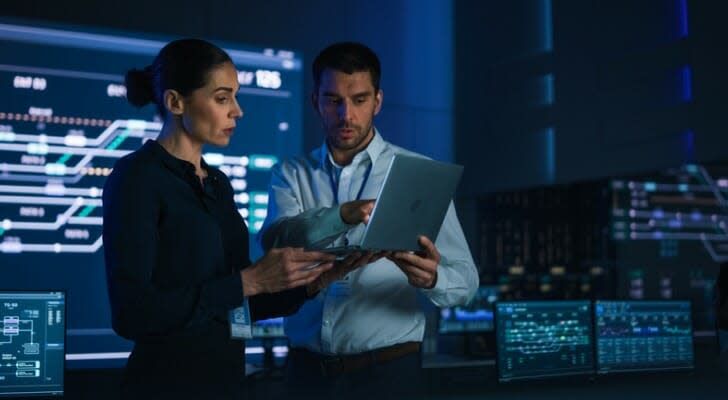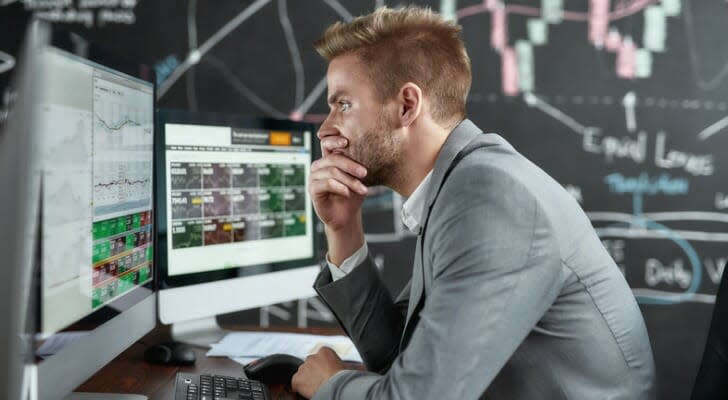What Investors Need to Know About Automatic Trading Systems
Investors use automatic trading systems to buy and sell securities without human intervention by following specific trading strategies using algorithms programmed into computer software. Automatic trading systems eliminate human emotions, enforce discipline, improve speed and reduce costs of trading. However, they must be overseen by human monitors or risk potentially disastrous missteps. Automated trading systems generate most trades today and are used by major investment houses, brokerages, hedge funds and other investment managers. To learn more about investing tools, or to analyze the best investments for you, consider talking to a financial advisor.
Automatic Trading System Basics
Automated trading systems are a type of algorithmic trading, which reduces investment decision-making to a set of rules expressed as a mathematical formula. Typically, these rules are connected to price movements. For example, the rule may specify buying a certain number of shares any time the price moves below a specific level, and then selling when the price rises above that level.
In automated trading systems, the formula does not just provide recommendations. They go a step further, granting the software running the algorithm the authority to autonomously initiate buy and sell orders for securities as indicated for maximum profit. High-frequency trading is another type of algorithmic trading that focuses on making a very large number of trades, each of which may produce only a minuscule profit.
Automated trading systems have been around for decades and have grown steadily in popularity. A broad cross-section of investment managers, hedge funds and brokerages have come to rely heavily on automated trading systems. Today most securities trades are initiated by these systems and the percentage is steadily growing.
Individual investors also use automated trading systems. Examples include MetaTrader 4, which provides options such as automatically copying trades of successful investors, and NinjaTrader, tailored for derivative and foreign exchange traders.
Robo-advisors are automated, but their autonomy is generally limited to asset allocation as opposed to active trading strategies. However, when automatically rebalancing portfolios and doing tax-loss harvesting robo-advisors may buy and sell securities on their own.
How Automatic Trading Systems Work
The heart of an automatic trading system is the software that buys and sells based on programmable rules. These rules are defined by the investor and tell the software when to enter orders and exit positions and how much money to invest.
The details of the rules can be as infinitely varied as the preferences of individual investors. Some rely on strategies such as picking market tops, while others seek to follow investing trends. Automated trading systems are restricted to using technical indicators since rules are triggered by data on market activity such as prices and volumes. Information about fundamentals, such as a dividend declaration or merger, is not considered.
To help them devise rules that will produce a profit, automated trading systems let investors try algorithms against past market activity in a procedure known as backtesting. For example, an automated trader will see how a set of rule-based investment decisions would work out if they had been implemented at some time in the past.
Automatic Trading System Benefits
Automated trading systems have important benefits. For one thing, they remove emotion from investing decisions. This can be very valuable in market selloffs when human fear can cause investors to sell at the wrong time. As a related benefit, automated trading systems enforce discipline and consistency. When investing decisions are in the hands of a computer programmed to follow a selected investing strategy precisely, it doesn’t matter if the investor is tempted to depart from the strategy by what looks like a tempting opportunity.
Automated trades involving only one computer talking to another are also much faster than trades requiring a human intermediary, and speed can be a great advantage in fast-moving markets. At the same time, they are faster, automated traders are also more precise and less susceptible to many types of error than humans.
Finally, harnessing machines to do work formerly done by humans makes automated trading much more efficient. Automated trades may even pay lower fees than human-assisted trades.
Automatic Trading System Drawbacks
Despite its pluses, automated trading by machines still requires human monitoring. Errors can crop up in code, connectivity to markets can be lost and there’s no guarantee that even the most carefully backtested rule will work in a live market.
In the worst case, automated trading system failures can do more than inconvenience individual investors. Precisely because of their speed and lack of human emotions such as shock and fear, automated trading systems can and do sometimes run amuck and cause disasters that sometimes shake whole markets. An example is the 2010 flash crash that created what was at the time the largest drop ever in the Dow Jones Industrial Average.
The Bottom Line
Automated trading systems turn the work of making and executing buy and sell decisions over to a computer. Trades are made according to rules, commonly tied to technical indicators based on stock price movements. The result can be a much more disciplined, precise, speedy and efficient approach to trading. Today, most trading activity in markets is initiated by automated trading systems. However, the systems still have to be overseen by humans to reduce the risk of possibly disastrous consequences.
Tips for Investing
Automated trading systems can’t replicate the human touch of a qualified and experienced financial advisor. Finding the right financial advisor that fits your needs doesn’t have to be hard. SmartAsset’s free tool matches you with up to three financial advisors who serve your area, and you can interview your advisor matches at no cost to decide which one is right for you. If you’re ready to find an advisor who can help you achieve your financial goals, get started now.
Automated trading system errors can destroy wealth as well as create it. This was shown in 2012 when mistakes in trading system code caused New Jersey-based Knight Capital to submit millions of erroneous orders within 45 minutes of the market opening. Before the problem could be corrected, the company had lost $460 million and was eventually forced to merge with another firm.
©iStock.com/Viktoriia Hnatiuk, ©iStock.com/gorodenkoff, ©iStock.com/LanaStock
The post Automatic Trading Systems: Investor’s Guide appeared first on SmartAsset Blog.



